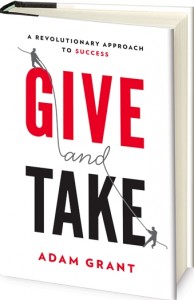 I am currently reading “Give And Take – A Revolutionary Approach To Success” by Adam Grant. I was not familiar with the book or the author but Give and Take came highly recommended by Jeremey Donovan who wrote “How To Give A TED Talk” that I reviewed earlier this year.
I am currently reading “Give And Take – A Revolutionary Approach To Success” by Adam Grant. I was not familiar with the book or the author but Give and Take came highly recommended by Jeremey Donovan who wrote “How To Give A TED Talk” that I reviewed earlier this year.
Rarely do I read a book in which I am not familiar with the author or the content. In the case of Give and Take, I’m glad I did. Grant has taken a very unique look at the difference between givers and takers and how different paths lead to different results.
This will be the second of three posts in which I will briefly summarize each of the nine chapters. Grant suggests that most people fall into one of two categories; givers and takers. Matchers are the in-between group and operate on the principal of fairness and strive to preserve an equal balance of giving and getting.
FINDING THE DIAMOND IN THE ROUGH – The Fact And Fiction Of Recognizing Potential
In the fourth chapter Grant shows how givers succeed by recognizing potential in others. This could be one of the best chapters I have ever read in any book. Grant sites several studies that have been conducted identifying the impact on performance based on how much belief is put into the given subjects.
The results very clearly suggest that although knowledge and intelligence can’t be completely ignored, test subjects that received affirmation and empowering encouragement achieved more that those who were simply given the test.
I have written more than once, that the greatest gift that you can give anyone is to believe in them. Grant’s referenced studies support the idea that those test subjects who were “believed in” scored higher in almost every test. The takeaway – believing in someone will empower them to achieve more than originally thought possible.
THE POWER OF POWERLESS COMMUNICATION – How To Be Modest And Influence People
Chapter five has Grant challenging the traditional assumptions about the importance of assertiveness and projecting confidence in gaining influence.
Theodore Roosevelt said; “Speak softly, but carry a big stick.” Powerless communication provides the feeling that the person you have spoken with fells just that – spoken with and not spoken to.
They are not told what to do or what to think, but rather the conversation is structured such that they feel like the thoughts and ideas have come from within.
Grant provides several examples supporting the idea that people perform on a higher level when they feel they have been involved in a collaborative effort and not directed to act or think in a specific way.
THE ART OF MOTIVATION MAINTENANCE – Why Some Givers Burn Out And Others Are On Fire
Chapter six examines why some givers burn out while others are on fire. In short, there are two types of givers; self-interest and other-interest.
Self-interest givers give and give with no real expectation of anything in return. Although a noble cause, this type of giving is not sustainable. Other-interest givers, on the other hand, give abundantly but keep their own goals and ambitions clearly identified and work towards them as well while seeking the win-win outcome.
While the selfless giver has a tendency to burn out over time the other-interest giver thrives on his success that impacts others as well as himself.
This book has really opened my eyes to the logic that sits behind our “giving.” These three chapters have been so full of content they could have easily been broken down in three separate posts. The concepts themselves challenge the reader to really take a hard look at the style and motives behind the way they give.
The next time you need something from one of your workers or even your kids for that matter, take a hard look at how you communicate YOUR desired outcome. When you can produce the mindset that the person is controlling their own outcome, you will not only empower that individual but I believe you will come much closer to the outcome you are looking for.
A very important question today – “What are you currently doing to empower those around you and what are you doing that tell them that you believe in them?”
click here and take The Give And Take Assessment.
***********************************************************************
Don’t miss a single post from Building What Matters by subscribing at the top left of this page.
Help support us by clicking here and Liking our facebook page
Barry Smith 8/14/13 photo courtesy of Amazon © Building What Matters 2013
//

